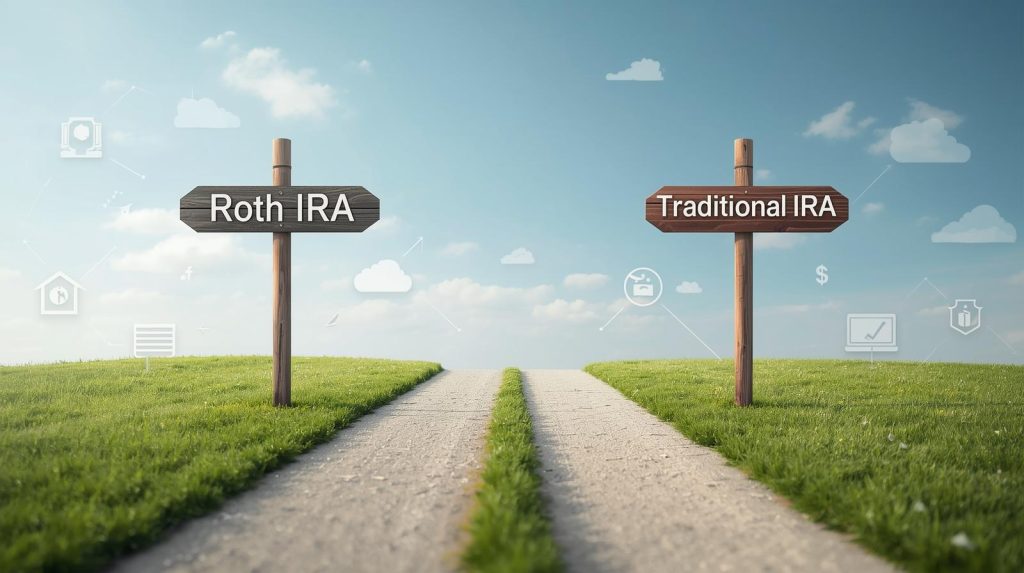
Why Retirement Accounts Matter for U.S. Investors
Retirement planning is one of the most important aspects of personal finance. For U.S. investors, Individual Retirement Accounts (IRAs) are powerful tools that provide tax advantages and long-term growth potential. Yet, many people are confused about whether they should choose a Traditional IRA or a Roth IRA.
The answer depends on your age, income level, and expectations about future taxes. Understanding the differences can help you make smarter decisions that directly impact your retirement lifestyle.
Understanding the Basics
What Is a Traditional IRA?
A Traditional IRA allows individuals to contribute pre-tax dollars. Contributions may be tax-deductible in the year they are made, lowering your taxable income. The money grows tax-deferred until you withdraw it in retirement, at which point it is taxed as ordinary income.
What Is a Roth IRA?
A Roth IRA, by contrast, is funded with after-tax dollars. You don’t get an upfront tax deduction, but your investments grow tax-free. Withdrawals in retirement—including both contributions and earnings—are not taxed, provided certain conditions are met.
Key Differences Between Roth and Traditional IRA
Tax Treatment
- Traditional IRA: Contributions may be tax-deductible, lowering taxable income in the contribution year. Withdrawals in retirement are taxed as ordinary income.
- Roth IRA: Contributions are made with after-tax dollars, but withdrawals in retirement—including earnings—are tax-free.
The fundamental choice is whether you want the tax benefit now (Traditional) or later (Roth).
Contribution Rules
- Traditional IRA: In 2025, contribution limits remain $7,000 annually (or $8,000 if age 50+). Income does not limit contributions, but tax deductibility phases out at higher incomes.
- Roth IRA: Same annual contribution limits apply, but high earners may face phase-out limits for eligibility.
Withdrawal Rules
- Traditional IRA: Required Minimum Distributions (RMDs) start at age 73. Early withdrawals before 59½ incur taxes plus penalties (with some exceptions).
- Roth IRA: No RMDs during the account holder’s lifetime, and contributions (not earnings) can be withdrawn anytime tax-free. This makes Roth more flexible for younger investors.
Which Option Fits Different Investor Profiles?
Young Professionals and Early-Career Workers
Roth IRA often works best for younger investors whose current tax rate is low. Paying taxes now in exchange for tax-free withdrawals later can be highly beneficial.
Mid-Career Investors
Traditional IRA may be attractive if you’re in a higher tax bracket now but expect a lower tax rate in retirement. This allows you to defer taxes while reducing today’s taxable income.
High-Income Earners
Roth IRA contributions may be restricted by income limits. However, high earners can consider a “backdoor Roth IRA” strategy—contributing to a Traditional IRA and then converting it to Roth.
Practical Considerations in 2025
Inflation, Tax Policy, and Future Projections
Inflation and potential changes in U.S. tax policy play a big role in choosing between Roth and Traditional. If tax rates rise in the future, Roth IRAs become more attractive. If you believe your retirement tax rate will be lower, a Traditional IRA may save more money.
Common Mistakes to Avoid
- Failing to diversify between Roth and Traditional accounts.
- Withdrawing early without understanding penalties.
- Ignoring employer-sponsored plans like 401(k)s, which can complement IRAs.
Choosing the Right Path for Your Retirement
Both Roth and Traditional IRAs offer powerful benefits for retirement planning.
- Choose Roth IRA if you want flexibility, no RMDs, and tax-free growth.
- Choose Traditional IRA if you prefer upfront tax deductions and expect lower taxes in retirement.
For many investors, a mix of both can provide balance and tax diversification. The key is aligning your IRA choice with your personal income level, long-term goals, and views on future tax policy.
Leave a Reply